The Blair Atholl Aeroplane Syndicate Ltd 1910 to 1914
| < Secret experiments at Blair Atholl | Δ Index | Birth of British Naval Aviation > |
In 1910, the then Marquis of Tullibardine, John George Stewart-Murray, heir to the Duke of Atholl, set up the Blair Atholl syndicate to support J. W. Dunne’s activities in building tailless aeroplanes. In 1911, The Marquis was the Chairman, Dunne became Chief Engineer and Charles Richard Fairey (who later founded Fairey Aviation) became General Manager of the syndicate, registered at 1 Queen Victoria Street, London, E.C., and operating from Eastchurch, Isle of Sheppey.
Dunne D.5
The first outcome of the syndicate was the D.5, which was built during 1910 by Short Brothers in their works at Leysdown, Isle of Sheppey, Kent, using Dunne’s design, but employing the constructor’s own discretion in the selection of materials and fittings to be used in the airframe.
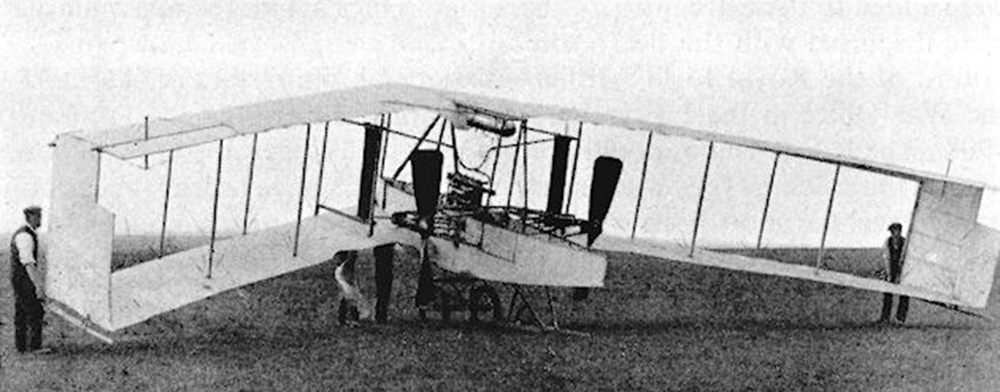 Dunne D5 showing the shape of the swept wing.
Dunne D5 showing the shape of the swept wing.
The machine was a two-seat tailless biplane with four-bay wings, the outer ends of which were enclosed by vertical fins with tip-skids below them. The first engine fitted was an eight-cylinder E.N.Y. “F” of 60 h.p., but this was changed to a 60 h.p. Green, the power being taken by chain-drive to a pair of outrigged 7 ft. diameter propellers, both of which turned in the same direction. The engine was housed in the centre of the boat-shaped nacelle, the nearest interplane struts to it carrying the cooling radiators. The pilot and passenger were seated in tandem, in the nose of the machine. A pair of sprung front wheels formed the main undercarriage, augmented by a third smaller wheel and two close-set skids to the rear. Flying controls consisted of ailerons on the tips of the upper wings.
They could operate by independent cockpit control either as rudders or as elevators, and automatic stability under varying conditions was promoted by wash-out at the tips of the wings.
On completion, the D.5 was taken to the Short Brothers flying-ground at Eastchurch and was tested there throughout 1910. By April, the machine was flying well, and in May it completed a flight of 2.25 miles, its stability being such that it was able to maintain a straight and level course without attention to the controls. At the end of 1910, on 20th December, the machine’s capabilities were demonstrated in flight by Lt. Dunne himself before Griffith Brewer and Orville Wright. During its trials at Eastchurch, the D.5 showed that it possessed perfect stability, and it fully vindicated its inventor’s theories. Flying of the D.5 continued the following year until it was wrecked completely when it was crashed by Dr. F. A. Barton’s son. The remains were salvaged and the machine was reconstructed, to emerge in 1912 as the single-engined D.8.
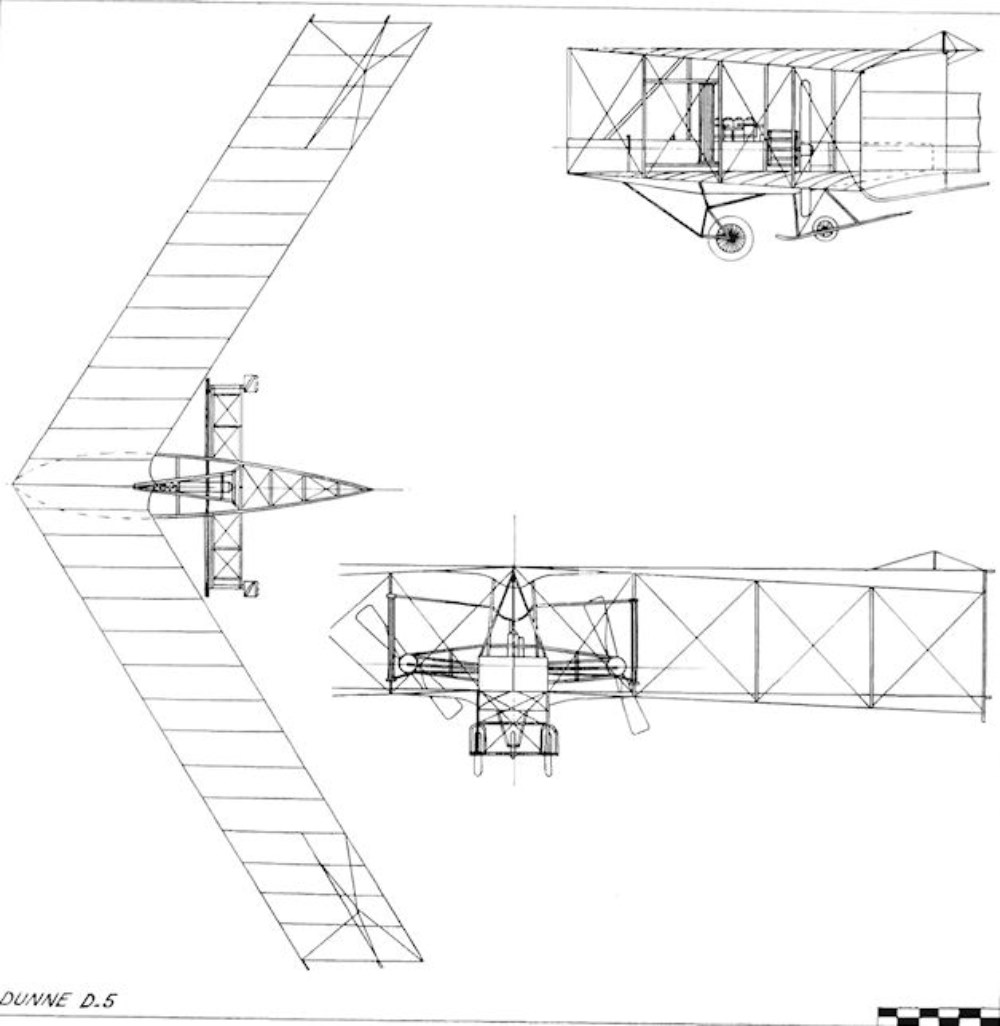 D5 Drawings.
D5 Drawings.
SPECIFICATION
Description: Two-seat tailless pusher biplane. Wooden structure, fabric covered.
Manufacturers: Short Brothers, Leysdown, Isle of Sheppey, Kent.
Power Plant: 60 h.p. E.N.V. “F”, 60 h.p. Green.
Dimensions: Span, 46 ft. Length, 20 ft. 4 5 ins. Wing area, 527 sq. ft.
Weights: Loaded, 1,550 lb.
Charles Richard Fairey
On seeing the machine in the air, the editor of Aeroplane magazine, remarked that he would like it better if it looked more like a flying machine. Charles Richard Fairey replied prophetically: “My dear sir, that is where you are in error, this is what a flying machine looks like”.
In 1911 Charles Richard Fairey then aged 24 became General manager of the Blair Atholl Syndicate Ltd. company formed to develop the tailless aircraft designed by J. W. Dunne.
In 1913 he joined Short Brothers as chief engineer and in 1915 he formed his own company, Fairey Aviation.
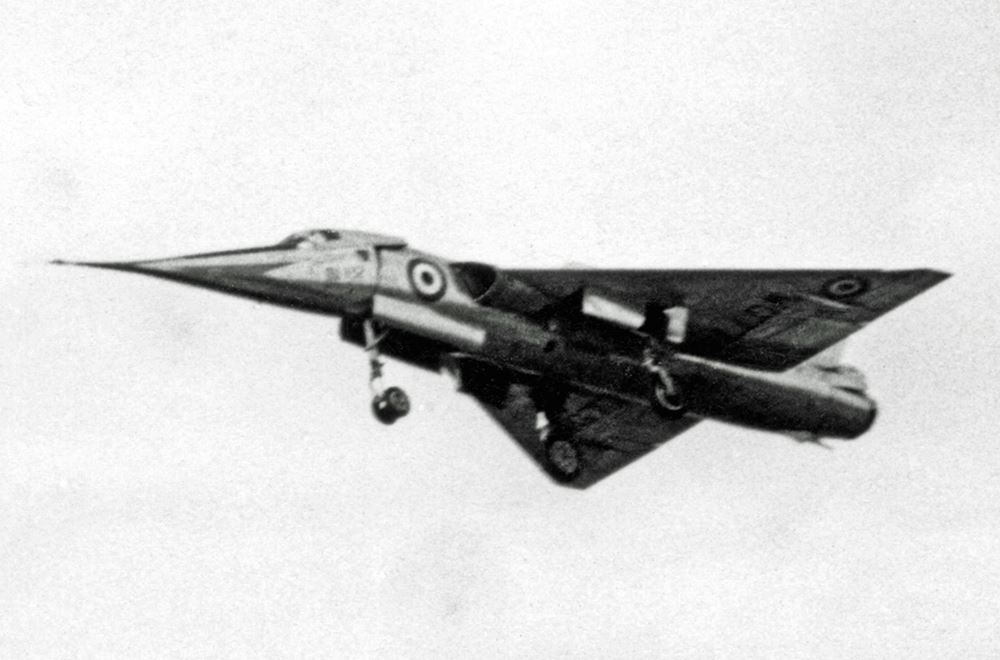 Perhaps their most famous design was the “droop-snoot” Fairey Delta – forerunner of Concorde.
Perhaps their most famous design was the “droop-snoot” Fairey Delta – forerunner of Concorde.
Dunne D.6, D.7 and D.7bis
Following the successful flights of the D.5 tailless biplane in 1910, Lt. J. W. Dunne embarked upon the design of a new tailless monoplane. The wings were set high in the parasol position, and the D.6, as it was designated, was derived from the model monoplane which Dunne had submitted in support of his original proposals to the War Office in 1905. These were refused, and he was persuaded to adopt, instead, the biplane form, a decision which, he stated many years later, he felt to be correct in the light of subsequent experience.
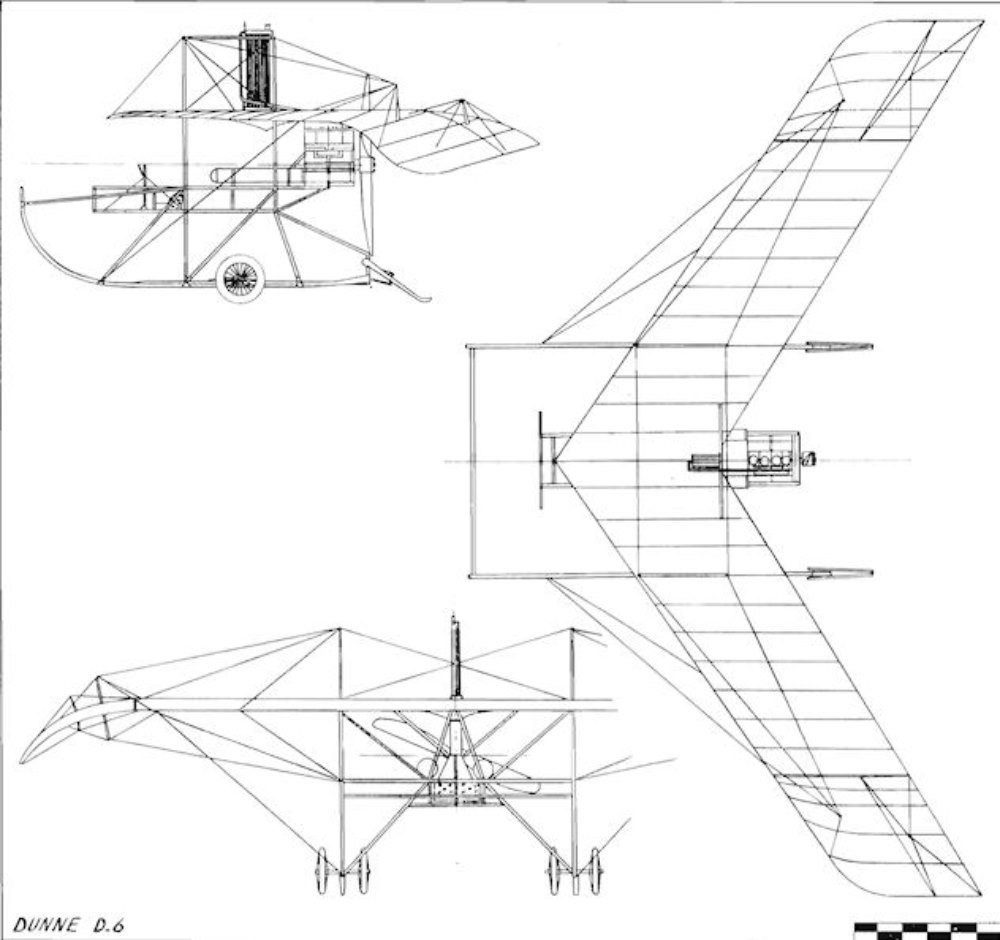 D6 Drawings
D6 Drawings
The same form of sweptback wings was employed as in the earlier aircraft built, but some minor modifications were incorporated. The degree of sweepback was increased slightly, and an interesting innovation was the alteration of the camber of the wing section which changed continuously from the leading-edge at the roots to the trailing-edge at the tips. Also in the interests of inherent stability, the wing-tips were the subject of pronounced wash-out, and their final few feet curved sharply downwards outboard of the centre of the ailerons to provide side area in the absence of fins or rudders.
The wings were above an open wooden framework which formed an uncovered fuselage carrying the single seat at the front, with the 60 h.p. Green engine and its 7 ft. 3 ins. diameter propeller at the rear. The water radiator was fitted vertically above the centre-section in an effort to keep the centre of gravity as high as possible. The entire machine was supported in a horizontal position on an undercarriage comprising two pairs of wheels combined with long, curved skids, at the rear of which were fitted shorter, sprung, shock-absorbing tail-skids. The ailerons, which operated either as elevators or rudders, were controlled independently by two levers from the pilot’s position.
SPECIFICATION
(D.6)
Description: Single-seat tailless pusher monoplane. Wooden structure, fabric covered.
Manufacturers: Short Brothers, Leysdown, Isle of Sheppey, Kent.
Power Plant: 60 h.p. Green.
Dimensions: Span, 36 ft. Length. 21 ft. Wing area, 230 sq. ft.
The D.6 was built by Short Brothers under the sponsorship of the Blair Atholl Aeroplane Syndicate, and the test flying was carried out by Dunne himself.
Dunne D.7
Col. J. E. Capper was interested in the design and ordered for himself a slightly smaller 50 h.p. Gnome-engined single-seat version, which was designated the D.7 Auto-Safety and was ready for display at the 1911 Olympia Aero Show. The span was 35 ft. and the wing area totalled 200 sq. ft. Empty and loaded weights were 1,050 lb. and 1,409 lb. respectively, and a 60 mph. maximum speed was achieved. During June, 1911, the D.7 was put through its tests at Eastchurch, Isle of Sheppey, and on 12th January, 1912. Dunne flew the machine without, for a period, using either his hands or feet on the controls.
Flight Magazine April 1 1911 included the following material:

“A monoplane that is altogether in a class by itself is the. Dunne, which is, so far as practical flying machines are concerned, an evolution of the Dunne biplane. The biplane was in itself, however, originally evolved from still earlier monoplane models. A characteristic feature of this machine is the absence of a tail and the V-plan form of the wings, which also have a varying angle of incidence from root to tip.
The object of the design is the acquisition of natural stability, and the purpose of sloping back the wings is to acquire an overall length for the machine as distinct from the chord dimension. This increment in length virtually introduces the principle of a tail, and the change in the angle of incidence throughout the succeeding sections of the wings confers the principle of the dihedral angle on the relative attitude of the virtual tail portion in respect to the central leading portion of the machine. In fundamental principle the Valkyrie appears to be not dissimilar to the Dunne, although there is no structural likeness whatever. The leading plane in the Valkyrie, however, may be likened to the central portion of the Dunne machine, and it makes a dihedral angle in respect to the main plane, the extremities of which correspond to the rearward tips of the Dunne wings. This comparison is, perhaps, not altogether conclusive as thus briefly drawn, but it has been made with the object of emphasising that it is in the underlying principle rather than in the form of the machine that types should be compared on a common scientific basis.”
D.7-bis
In 1912, the original D.6 single-seater was converted into the D.7bis two-seater and was given the extra power of the 70 h.p. Gnome engine to cope with the additional weight. The wing was remodelled to match that of the D.7, with a span of 35 ft. and an area of 200 sq. ft. The machine weighed 1,200 lb. empty and 1,728 lb. loaded, and had a maximum speed of 60 m.p.h.
Dunne D.8 and D.10
Lt. J. W. Dunne’s final designs for the Blair Atholl Aeroplane Syndicate reverted to the biplane form in his D.8 and D.10 two-seaters built by Short Brothers at Leysdown, Isle of Sheppey, Kent, during 1911-12.
The D.8 was a single-engined conversion of the crashed D.5 of 1909-10, and used the same wings of 45 ft. span, with a chord of 6 ft. and a similar sweepback angle of 30°. The wing-tips were enclosed by fixed vertical fins, the flying controls consisting of split ailerons extending across the trailing-edges of the two outermost bays on the four planes. They were operated independently of each other as rudders for turning, or they could be employed as elevators using both flap sections on each side in unison for “up” or “down”. The wings of the D.8 demonstrated in a pronounced way the Dunne method of obtaining stability by changing the camber of the wing section continuously across the span from the leading-edge at the roots to the trailing-edge at the tips.
The nacelle was mounted between the lower wings, the pilot sitting at the front, with his passenger towards the rear and just ahead of the fuel tanks. Both flyers could handle the machine, as dual control levers were installed. The undercarriage was a fairly complex but successful unit designed specially to allow the D.8 to operate without fear of damage from the comparatively rough aerodromes in use. The front strut system and sprung skid were of wood, while the rear sprung chassis carrying the twin wheels was composed of steel tubing. Long sprung skids supported the tips of the wings on the ground.
In the D.8, twin propellers were abandoned in favour of the simplicity of a single one, 8 ft. 2 ins. in diameter, driven direct by a 50 h.p. Gnome engine at the rear of the nacelle.
The D. 10 was another two-seater built during 1912. It was fitted with an 80 h.p. Gnome and was converted later to a D.8. The span was 45 ft., with a wing area of 448 sq. ft. and a loaded weight of 2,202 lb. Maximum speed was 50 mph, a drop of 5 m.p.h. from the 55 m.p.h. of the first D.8, which was brought about by the increase of weight.
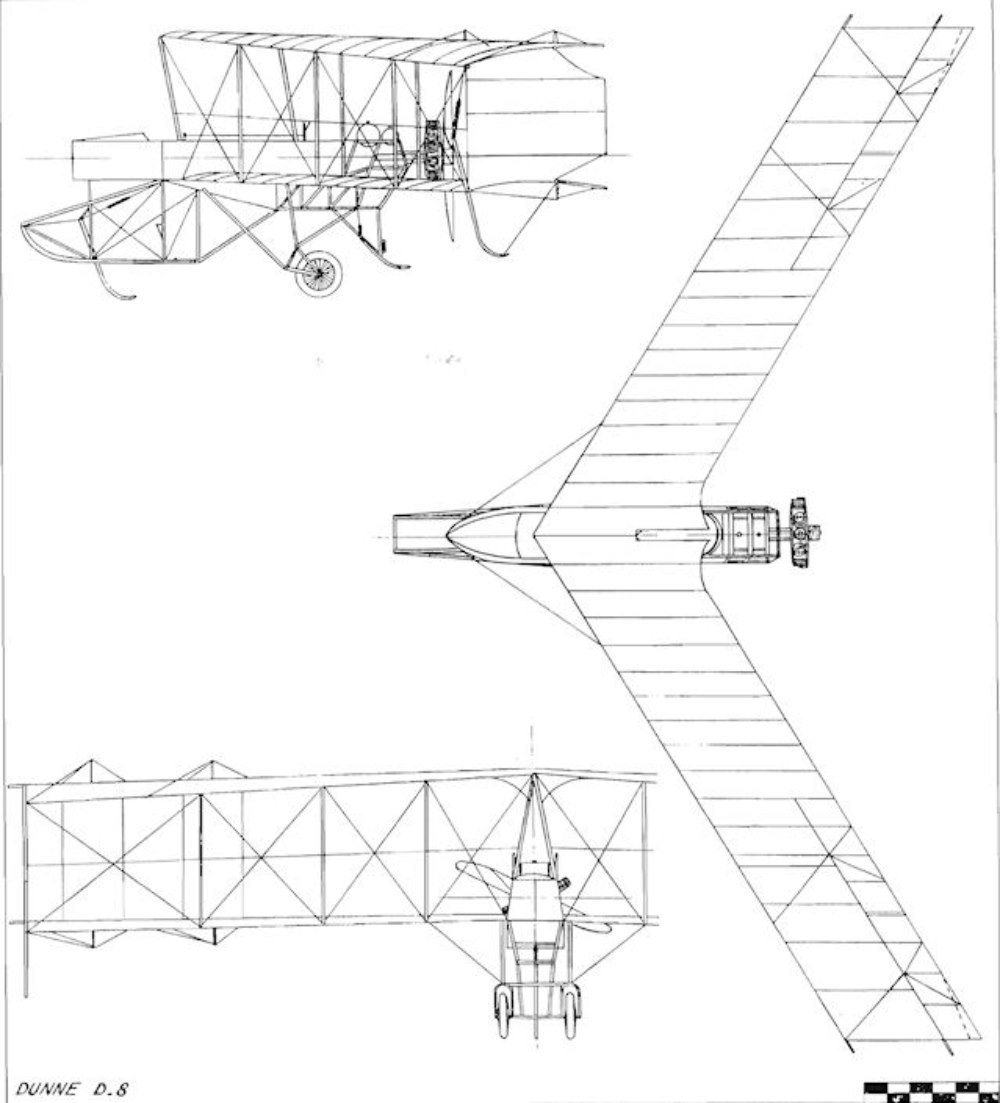 D.8 Drawings
D.8 Drawings
SPECIFICATION (D.8)
Description: Two-seat tailless pusher biplane. Wooden structure, fabric covered.
Manufacturers: Short Brothers, Leysdown, Isle of Sheppey, Kent.
Power Plant: 50 h.p. Gnome, 60 h.p. Green, 80 h.p. Gnome.
Dimensions: Span, 46 ft. Wing area, 545 sq. ft.
Weights: Empty, 1,400 1b. Loaded, 1,900 lb.
Performance: Maximum speed, 55 m.p.h.
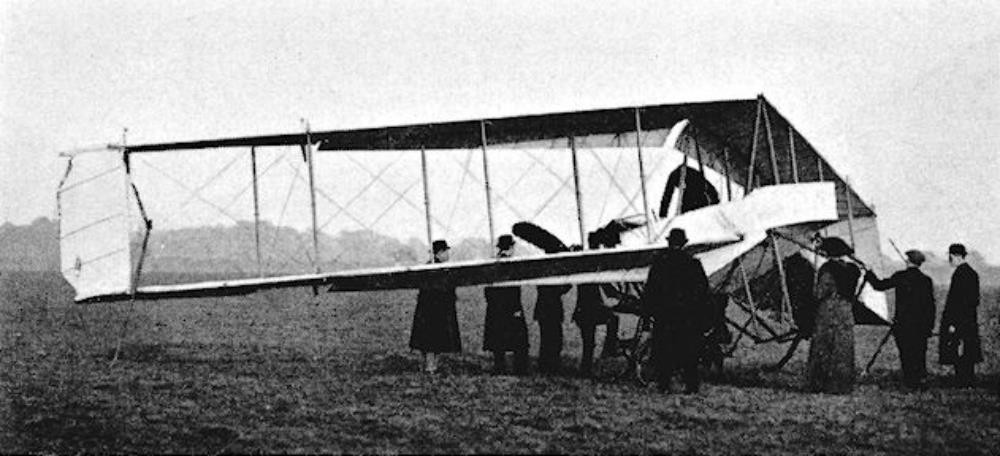
Dunne D.8
 Dunne D.8 with 80 h.p. Gnome.<
Dunne D.8 with 80 h.p. Gnome.<
 Dunne D.8 with 50 h.p. Gnome.
Dunne D.8 with 50 h.p. Gnome.
 Burgess-Dunne. License-built variants derived from the D.8 and manufactured under license in U.S. from 1913 to 1916; land- and seaplane versions; flew with U.S. and Canadian military air arms
Burgess-Dunne. License-built variants derived from the D.8 and manufactured under license in U.S. from 1913 to 1916; land- and seaplane versions; flew with U.S. and Canadian military air arms
Dunne-Huntington Triplane
Professor A. K. Huntington of the Institute of Materials, Minerals and Mining was a founder and active committee member of the Royal Aero Club. He moved on from balloons to build and fly his own aeroplane, to a design provided by J. W. Dunne. The Dunne-Huntington triplane was an unusual design, variously referred to as a triplane, a biplane or a tandem monoplane. Dunne produced the original design for Huntington during the winter of 1907–08.
The upper wings were of straight planform, while the lower pair were positioned to the rear and were swept back. Outboard of the inter-plane fins, the lower tips were given sharp anhedral with their rear triangular portions hinged to provide flying controls. The fore-planes were mounted in line with the lower wings, being braced to the rear wings and fitted on the nose of the open fuselage. The twin propellers were borne on shafts extending forwards from the lower rear wings, and were driven by chains from the water-cooled engine set behind the pilot, who was seated in an opening in the centre of the fore-planes. The engine’s radiator was installed mid-way along the fuselage, and the undercarriage comprised a pair of coil-sprung main wheels with a third wheel at the rear of the machine.
Huntington started testing the aircraft at Eastchurch during April, 1910, and although he managed to get it to take-off, the performance was not altogether satisfactory.
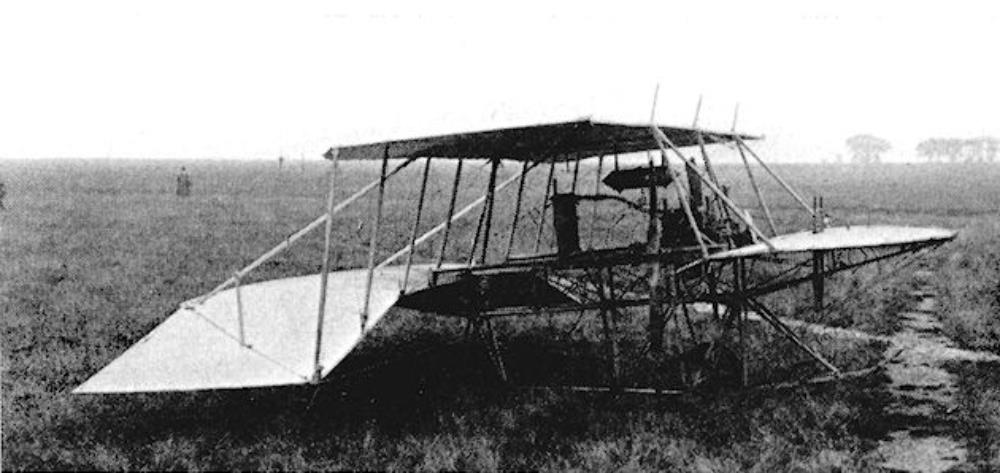 The first version at Eastchurch in 1910 with Wolseley engine, four wheels and skid undercarriage.
The first version at Eastchurch in 1910 with Wolseley engine, four wheels and skid undercarriage.
For the next three years, during his spare time, he continued to experiment, altering the rear wings and changing the engine to a 70 h.p. Gnome rotary, so that by April, 1913, the Dunne-Huntington was flying well. Maximum speed, 43 m.p.h.
Huntington experimented with a number of improvements over the next few years, notably the substitution of a Gnome rotary engine, and it was still flying well into 1914.
 Dunne-Huntington Triplane with revised three-wheel undercarriage and inter-plane fins.
Dunne-Huntington Triplane with revised three-wheel undercarriage and inter-plane fins.
1914 – Armstrong Whitworth
In 1914 the great engineering company Armstrong Whitworth decided to move into aeronautics and bought the struggling syndicate’s assets.
Dunne in later life
After abandoning aeroplane design, Dunne brought his intense focus to two new endeavours. In 1924 he published his first book, on dry fly fishing, with a new method of making realistic artificial flies.
Meanwhile, he was studying precognitive dreams which he believed he and others had experienced. By 1927 he had evolved the theory of serial time for which he would become famous and published an account of it, together with his dream researches, in his next book “An Experiment with Time.”
On 3 July 1928, at the age of 52, he married the Hon. Cicely Twisleton-Wykeham-Fiennes, and they lived at the family seat of Broughton Castle near Banbury.
They had two children and he wrote up some of his bedtime stories to them in two more books, The Jumping Lions of Borneo and St. George and the Witches.
Dunne died in Banbury, England, on 24 August 1949, aged 73.
| < Secret experiments at Blair Atholl | Δ Index | Birth of British Naval Aviation > |